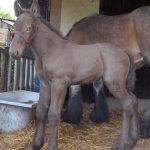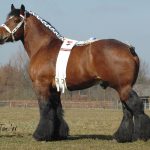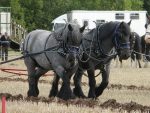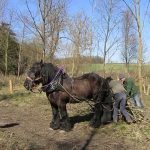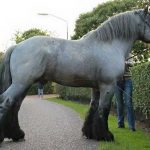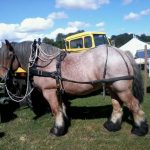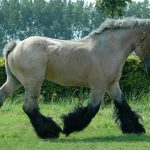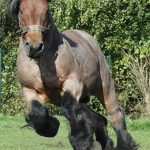Dutch Draft
The massively built Dutch Draft, also famous as Nederlands Trekpaard, is a breed of draft horses that resemble the Belgian Draft and Ardennes horses in build and appearance. Aside from driving and farm work, Dutch Drafts are now used for recreation and have taken part in dressage competitions.
Dutch Draft Pictures
- Dutch Draft Foal
- Dutch Draft Horse
- Dutch Draft Images
- Dutch Draft Pictures
- Dutch Draft Stallion
- Dutch Heavy Draft Horse
- Dutch Heavy Draft
- Dutch Draft
Quick Information
| Temperament/Personality | Calm, friendly, docile, quiet |
| Physical Characteristics | Solidly built, head has a straight profile, short and lively ears, strong, muscular chest, good withers, heavily muscled hindquarters and loin, stocky, heavily feathered legs, sound feet |
| Colors | Chestnut, bay, gray, occasionally black |
| Height (size) | Male: about 16 hands (63 inch, 160 cm) Female: about 15.2 hands (61 inch, 155 cm) |
| Weight | Male: 1653 lbs (750 kg) Female: 1543 lbs (700 kg) |
| Blood Type | Cold-blooded |
| Common Uses | Draft work, riding horse |
| Health | A healthy breed; owners should ensure that their horse is on a healthy diet, also take it to the vet |
| Gaited | Yes; unhurried and precise movements |
| Popular Traits | Strength, quiet disposition, ability to work for a prolonged period |
| Feeding/Diet | Grass, hay, beet pulp, vitamin, and mineral concentrates |
| Country of Origin | The Netherlands |
| Ancestors | Belgian Brabant, Ardennes, Zeeland horse |
| Breed Registry/Association | Koninklijke Vereniging Het Nederlandse Trekpaard en de Haflinger, Stichting het Werkend Trekpaard Zeeland |
Video: Dutch Heavy Draft Pulling a Harrow
History and Development
A few years after the World War I, the Dutch Draft was developed by crossing the local Zeeland draft mares with Brabant and Ardennes stock. It was one of the most popular horse breeds in the Netherlands, as it was commonly used in agriculture and farm work in the provinces of North Brabant, Zeeland, and Groningen. After the World War II, increased mechanization and motorization caused a decline in the population of heavy draft horses. However, a number of sound breeding animals were preserved by enthusiasts and breeders. The “Koninklijke Vereniging Het Nederlandse Trekpaard en de Haflinger” was established in the early 20th century for preserving the breed.


